National symbols of Canada
| Part of a series on the |
| Culture of Canada |
|---|
| History |
| Topics |
| Research |
|
|
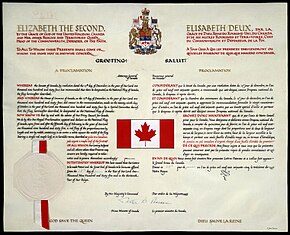
Over the course of centuries, a multitude of national symbols and material items have arisen as uniquely Canadian or possessing uniquely Canadian characteristics. These symbols and items represent the culture of Canada—protectionism of that culture, identity, values, nationalism, and the heritage of its inhabitants.[1]
Themes and symbols of nature, pioneers, trappers, and traders played an important part in the early development of Canadian symbolism.[2] Modern symbols emphasize the country's geography, cold climate, lifestyles and the Canadianization of traditional European and indigenous symbols.[3]
A 2013 Statistics Canada survey found that more than 90% of Canadians believed that the national flag and the Canadian Charter of Rights and Freedoms were the top symbols of Canadian identity. Next highest were the national anthem (O Canada), the Royal Canadian Mounted Police and ice hockey.[4] A similar poll by Ipsos Reid in 2008 indicated that the maple leaf was the primary item that defines Canada. Followed by ice hockey, the national flag, the beaver, the Canadarm, Canada Day and Canadian Forces peacekeeping.[5]
Predominant symbols[]

Canada’s most well known symbol is the maple leaf, which was first used by French colonists in the 1700s. Since the 1850s under British rule, the maple leaf has been used on military uniforms and subsequently engraved on the headstones of individuals who have served in the Canadian Armed Forces.[7] The maple leaf is prominently depicted on the country's current and previous flags, and on the coat of arms (or royal arms). The maple leaf has also been seen on the penny before the penny officially stopped circulation in 2013. Canada's official tartan known as the "Maple leaf tartan" four colours reflect the colours of the maple leaf as it changes through the seasons—green in the spring, gold in the early autumn, red at the first frost, and brown after falling.[8]
Other prominent symbols include the national motto "A Mari Usque Ad Mare" (From Sea to Sea),[9] the sports of hockey and lacrosse, the beaver, Canada Goose, Canadian horse, the Royal Canadian Mounted Police, the Canadian Rockies, the Canadian parliamentary complex, the Canadarm,[10] and more recently the Canadianization of totem poles and Inuksuks.[11] With material items such as Canadian beer, maple syrup, tuques, canoes, nanaimo bars, butter tarts and the Quebec dish of poutine being defined as uniquely Canadian.[11][12] A six pointed hexagonal snowflake used as the insignia for the Order of Canada (a national honour system) has come to symbolize Canada's northern heritage and diversity.[13] The country's institutions of health care, military peacekeeping, the national park system and the Canadian Charter of Rights and Freedoms are seen as uniquely Canadian by its citizens.[14][15]
The Crown displaying traditional cross pattées and fleurs-de-lis symbolizes the Canadian monarchy,[16] and appears on the coat of arms (used by parliamentarians and government ministries), the flag of the Governor General,[16] the coats of arms of many provinces and territories; the badges of several federal departments, the Canadian Armed Forces and Royal Military College of Canada, many regiments, and other police forces; on buildings, as well as some highway signs and licence plates. Also, the Queen's image appears in Canadian government buildings, military installations and schools; and on Canadian stamps, $20 bank notes, and all coins.
Official and de facto symbols[]
The following is a list of official and "De facto" symbols as recognized by the government of Canada.[17]
| Symbol | Image | Notes |
|---|---|---|
| National flag[17] | 
|
Official symbol as of February 15, 1965[17] |
| Royal standard[16] | 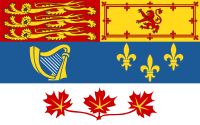
|
Royal symbol - adopted and proclaimed by Queen Elizabeth II in 1962 for her use in her capacity as Queen of Canada.[18] |
| Viceregal standard | 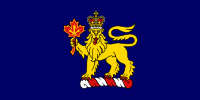 |
Royal symbol adopted 1981 - current version 2005[19] |
| Royal cypher[16] | 
|
Royal symbol since 1952[20] |
| Royal arms[17][21] |  Most recent rendition 1994, still in official use 1957 rendition displayed here |
Official symbol as of November 21, 1921[17] |
| Great Seal[17] | 
|
De facto symbol since 1867 - (current version November 14, 1955).[17] |
| National anthem[17] |  "O Canada" |
Official since July 1, 1980 (song dates to 1880)[17] |
| Royal anthem[16] | 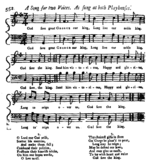 "God Save the Queen" |
De facto Royal anthem that dates to 1745[22] |
| Motto[17] | A Mari Usque Ad Mare (From sea to sea) |
Officially adopted November 21, 1921[17] |
| National colours[17] | Red White |
Official symbol as of November 21, 1921 by order of King George V[17] |
| National tree[17] |  Sugar maple |
Official symbol since 1996[17] |
| Additional national symbol[17] | 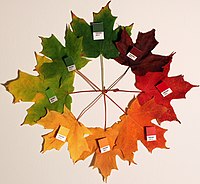 Maple leaf |
De facto symbol since 1700s[17] |
| National animals[17] | 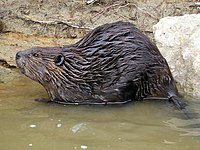 North American beaver |
Official symbol since 1975[17] |
 Canadian horse |
Official symbol since 2002[17] | |
| National sport[17][23] | 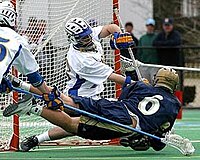 Lacrosse (summer) |
Officially adopted on May 12, 1994[17] |
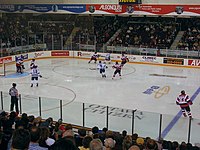 Ice hockey (winter) |
Officially adopted on May 12, 1994[17] | |
| National tartan[17] | 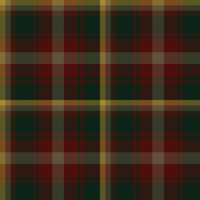 Maple Leaf Tartan |
Officially adopted on March 9, 2011[17] |
| Royal Canadian Mounted Police[17] | 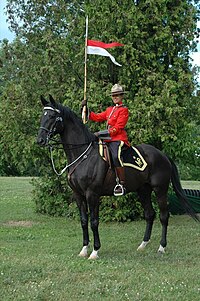 Royal Canadian Mounted Police Officer |
De facto symbol since 1920[17] |
| Parliament Hill[17] |  Parliament Hill |
De facto symbol built between 1859–1927[17] |
See also[]
- Anthems and nationalistic songs of Canada
- Events of National Historic Significance
- Great Canadian Flag Debate
- List of Canadian awards
- List of Canadian flags
- National Historic Sites of Canada
- Orders, decorations, and medals of Canada
- Orders, decorations, and medals of the Canadian provinces
- Persons of National Historic Significance
- Regional tartans of Canada
References[]
- ^ Michael Dawson; Donald A. Wright; Catherine Anne Gidney (2018). Symbols of Canada. Between the Lines. p. 32. ISBN 978-1-77113-371-5.
- ^ "Canada in the Making: Pioneers and Immigrants". The History Channel. August 25, 2005. Retrieved November 30, 2006.
- ^ Cormier, Jeffrey. (2004). The Canadianization Movement: Emergence, Survival, and Success. 10.3138/9781442680616.
- ^ "The Daily — Canadian identity, 2013". www.statcan.gc.ca. Retrieved 2015-10-01.Canadian Identity, 2013 - By Maire Sinha
- ^ Defining Canada: A Nation Chooses The 101 Things That Best Define Their Country "Unprecedented, Definitive National Survey Identifies Top People, Places, Events, Accomplishments and Symbols that Define Canada. As Chosen By Canadian. Ipsos Reid on behalf of the Dominion Institute and the Department of Citizenship and Immigration Canada, 2008. PDF version
- ^ Monaghan, David (2013). "The mother beaver – Collection Profiles". The House of Commons Heritage. Archived from the original on December 22, 2015. Retrieved December 12, 2015.
- ^ Michael Dawson; Donald A. Wright; Catherine Anne Gidney (15 October 2018). Symbols of Canada. Between the Lines. ISBN 978-1-77113-371-5.
- ^ "Maple Leaf Tartan becomes official symbol". Toronto Star. Toronto. March 9, 2011.
- ^ Reingard M. Nischik (2008). History of Literature in Canada: English-Canadian and French-Canadian. Camden House. pp. 113–114. ISBN 978-1-57113-359-5.
- ^ Canadian Heritage (2002). Symbols of Canada. Canadian Government Publishing. ISBN 978-0-660-18615-3.
- ^ a b Sociology in Action, Canadian Edition, 2nd ed. Nelson Education-McGraw-Hill Education. p. 92. ISBN 978-0-17-672841-0.
- ^ Hutchins, Donna; Hutchins, Nigel (2006). The Maple Leaf Forever: A Celebration of Canadian Symbols. Erin: The Boston Mills Press. p. iix intro. ISBN 978-1-55046-474-0.
- ^ "Canadian Honours > Order of Canada > Levels and Insignia". The Governor General of Canada. 2002.
- ^ The Environics Institute (2010). "Focus Canada (Final Report)" (PDF). Queen's University. p. 4 (PDF page 8). Archived from the original (PDF) on February 4, 2016. Retrieved December 12, 2015.
- ^ Nanos Research (October 2016). "Exploring Canadian values" (PDF). Archived from the original (PDF) on April 5, 2017. Retrieved February 1, 2017.
- ^ a b c d e "The Crown in Canada". Department of Canadian Heritage. Archived from the original on 2011-08-27. Retrieved 2011-07-27.
- ^ a b c d e f g h i j k l m n o p q r s t u v w x y z aa ab ac Canadian Heritage (2002). Symbols of Canada. Canadian Government Publishing. ISBN 978-0-660-18615-3. Unofficial symbols of Canada, Official symbols of Canada, Royal symbols and titles
- ^ Heritage, Canadian (11 August 2017). "Canadian flags of the Royal Family". aem.
- ^ General, The Office of the Secretary to the Governor. "Governor General of Canada [Civil Institution]". reg.gg.ca.
- ^ Heritage, Canadian (11 August 2017). "Royal Crown and Cypher". aem.
- ^ "The arms of Canada". Department of Canadian Heritage. Archived from the original on 2009-02-28. Retrieved 2011-07-27.
- ^ Heritage, Canadian (11 August 2017). "Royal Anthem". aem.
'O Canada' and 'God Save the Queen'/'Dieu sauve la Reine' were approved by Parliament in 1967 as Canada's national and royal anthems. However, legislation to this effect was passed only in 1980, and applied only to 'O Canada.'
{{cite web}}: External link in|quote= - ^ "National Sports of Canada Act, CHAPTER N-16.7". Code of Canada. Government of Canada. 12 May 1994. Archived from the original on 19 April 2012.
External links[]
- National symbols of Canada
